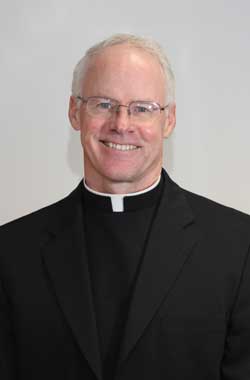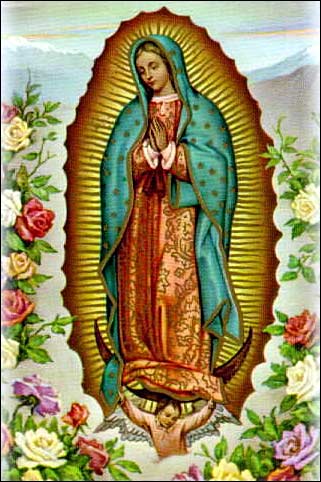
The Bridges, a column about the fictional Bridges family, is written by Father John J. Ames, deputy secretary for the Office for Catechetical Formation for the Archdiocese of Philadelphia.
Tom: So much for getting a jump on the rush hour. Must be an accident; there’s flashing lights up by the church. Hold on … it looks like a parade!
Pop: A parade at six in the morning? Wait a minute. I read about this in the church bulletin. It’s the procession for Our Lady of Guadalupe. I had no idea it could shut down Street Road. Look at all the people!
Mention “December” and thoughts of Advent and Christmas dance in our heads. However, nestled right in the middle of the first Sunday of Advent (Dec. 2) and Christmas is the Feast of our Lady of Guadalupe (Dec. 12).
In 1531, on the morning of Dec. 12, Juan Diego made his way through the hills to Mass in Mexico City. As the 57-year-old Aztec Indian walked the familiar path, he suddenly heard music and a woman’s voice calling “Juan, Juan.” Juan climbed Tepeyac Hill and encountered a beautiful, young Indian woman. She identified herself as the Virgin Mary and instructed him, “Tell the bishop that I desire a church to be built on this spot. This church will aid the conversion of the Mexican people and be a source of consolation for many.”
Juan told his story to the bishop, who hesitated and directed him to ask for a miraculous sign. Juan returned to the Lady and reported the Bishop’s request. Roses appeared on the usually barren hillside. Juan gathered the flowers and she arranged them in his cloak, or tilma. “There, now,” she smiled. “Take these roses to the bishop.”
When Juan opened the cloak before the bishop, the flowers fell to the floor and there was the image of the Virgin of Guadalupe, miraculously imprinted on his tilma. Soon, a church was built. Today, Guadalupe is the most frequented Marian shrine in the whole world. Numerous miracles, cures and interventions are attributed to her. She is the “Patroness of the Americas.”
 There are so many lessons to be learned from the apparition.
There are so many lessons to be learned from the apparition.
• Mary bows humbly with eyes of tenderness. Her message is one of love, compassion, and a promise of protection. “Hear me and understand well that nothing should frighten or grieve you. Let not your heart be disturbed. Am I not your Mother? Are you not under my protection?” In this “Year of Faith” we are invited to a deeper faith in Jesus. Juan Diego is an inspiration for all of us to trust, even when things seem impossible.
• Mary, surrounded by rays of light, stands on a crescent moon, and wears a dark band around her waist, symbolizing that she is pregnant. We recall the Woman of the Apocalypse described in the Book of Revelation: “A great sign appeared in the sky, a woman clothed with the sun, with the moon under her feet, and on her head a crown of twelve stars. She was with child….” The Aztecs often sacrificed their children to pagan gods. Aware that our own country sacrifices so many children through abortion, we seek the aid of Our Lady of Guadalupe, whom Pope John Paul II declared to be the “Patroness of the Unborn.”
• St. Juan Diego’s tilma, with its miraculous image, hangs in the Basilica of Our Lady of Guadalupe. Although hundreds of years have passed, the poor quality cactus fiber shows no sign of decay and defies all scientific explanation. Is this one more way that Mary is letting us know that she remains with us on our journey through life?
• Mary appeared to Juan Diego as a beautiful Aztec princess speaking to him in his own Nahuatl language. The missionaries who first came to Mexico had little success. Native Mexicans did not understand them. Within a few years after the apparition, 8 million people had converted to Catholicism. If we want to help someone embrace Jesus, we must appreciate their culture and mentality. By understanding them, we can help them to know and love Christ. It is not surprising that Our Lady of Guadalupe is known as the “Star of the New Evangelization.”
The feast day of Our Lady of Guadalupe is popular, particularly among Latino Americans. Tom and Pop Bridges learned that when they got stuck in a traffic jam the morning of Dec. 12. In Latino culture, the festival of Our Lady of Guadalupe actually begins a week before. Families prepare food and decorate homes. On the evening of Dec. 11, there is music, song and dance. On the feast day, people join in candlelight procession to morning Mass while singing mananitas (morning songs). After Mass, everyone returns home for a day of feasting and celebration that concludes with another procession at night. Sounds pretty good to me!
A little more on ‘Las Mananitas’
Las Mananitas are traditional songs that Mexican people sing early in the morning on special occasions, including the morning of the Feast of Our Lady of Guadalupe. There are many verses, but this is the English translation of the most common verse:
These are the morning verses
That King David used to sing.
Because today is your feast day,
We are singing them to you.
ChorusAwaken, my dear, awaken,And see that the day has dawned; Now the little birds are singing, And the moon has set.



Share this story